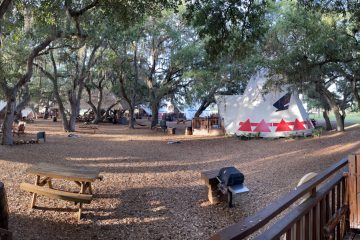Spontaneity…. suspense…. surprise. Are these words that you would use to describe your travel? Neither would we, usually. I mean, we have traveled spontaneously before, and we have left our plans in the hands of fate. We normally plan trips ourselves (or use the services of travel specialists or agents), usually knowing what we will be seeing or doing and when. So imagine if you will a travel service that plans your trip, your lodging, your transportation and even your events and does not tell you where you are going. They leave it as a surprise. Introducing Pack up and Go.
At “Pack up and Go”, you answer a few questions on their survey. They ask your likes (and dislikes), they ask for places you would like to see and things you would like to do. They ask how structured you want your trip to be, from “plan everything on a schedule” to “freestyle”. They plan your trip for you and they don’t tell you anything about it. You pick the date you want to go, but that is all you know. Then about a week before your trip, they send you a sealed packet with warning not to open it until you arrive at the airport. They also send you an email with a redacted weather forecast (so you know how to pack).
 On the day of your departure, you are instructed to go airport and to the terminal designated before you open your envelope. Our instructions were to go to the Blue Terminal at Tampa International by 7am.
On the day of your departure, you are instructed to go airport and to the terminal designated before you open your envelope. Our instructions were to go to the Blue Terminal at Tampa International by 7am.
We arrived and ready and anxious to know where we going. We parked and made our way to the terminal. We stood under the Arrival/Departures boards with our envelope… Ready, Set, GO!
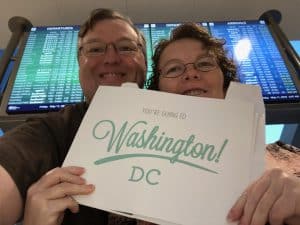 We opened our envelope, pulling out the inner envelope and found that our destination was……
We opened our envelope, pulling out the inner envelope and found that our destination was……
Washington, DC.
I was both excited and a bit disappointed. We had been to Washington DC before and I liked to go to new places. Still, it had been 10 years and there is SO much to see in DC. I put my disappointment aside. Let’s go!
Since we were already checked in (they do that for you ahead of time in order to keep the surprise), we went to the ticket counter and got our boarding passes. Once through security, we had a moment to open our packet and see what was being planned for us.
Teresa had filled out the survey for us, describing us as “foodies” who like to freestyle. In our packet were lists of places to see, restaurants to explore, festivals and more. There was an Uber code, to help us get around and the place of our lodging, the Hotel Palomar.
Washington DC – Pack up and Go
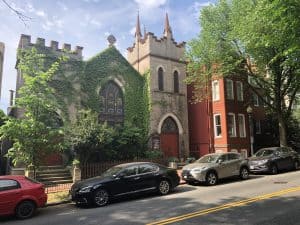 We arrived and Ubered to the hotel. It was centrally located near Dupont Circle and Embassy Row. There was also a subway station nearby.
We arrived and Ubered to the hotel. It was centrally located near Dupont Circle and Embassy Row. There was also a subway station nearby.
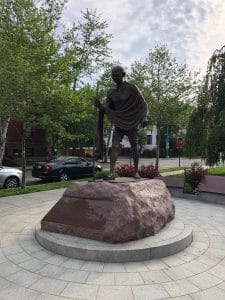 Embassy Row is the informal name for the section of Massachusetts Avenue, N.W. between Scott Circle and the North side of the United States Naval Observatory, in which embassies, diplomatic missions, and other diplomatic representations are concentrated. By extension, the name may be used to encompass nearby streets which also host diplomatic buildings. (source)
Embassy Row is the informal name for the section of Massachusetts Avenue, N.W. between Scott Circle and the North side of the United States Naval Observatory, in which embassies, diplomatic missions, and other diplomatic representations are concentrated. By extension, the name may be used to encompass nearby streets which also host diplomatic buildings. (source)
The White House
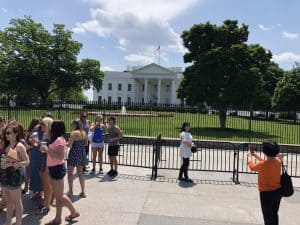 After unpacking, we decided to walk to the Smithsonian. The trek took us past the White House. We were too late to get tour passes (again). It was not on our list of things to see this time. We wanted to get to the Smithsonian.
After unpacking, we decided to walk to the Smithsonian. The trek took us past the White House. We were too late to get tour passes (again). It was not on our list of things to see this time. We wanted to get to the Smithsonian.
Smithsonian

One of the Smithsonian galleries, the National Air and Space Museum has a tribute/display of the hotel from “2001: A Space Odyssey.” It was amazing to be able to walk through it. Little touches and details makes me want to see the movie again.
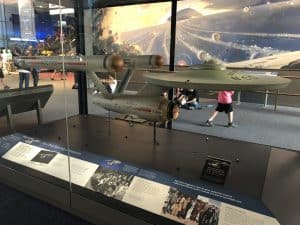
One of the most icon starships is “docked” at the National Air and Space Museum too. The starship “Enterprise, NCC-1701” is on permanent display here. It is the original screen model from “Star Trek”, restored and on exhibit. It was amazing to see.
This model of the fictional starship Enterprise was used in the weekly hour-long “Star Trek” TV show (NBC-TV), which aired from September 1966 until June 1969. Despite its short initial run (only three seasons), Star Trek became one of the most popular shows in the history of television. The show’s depiction of a racially-integrated, multinational crew of men and women working together successfully, as well as its attention to contemporary social and political issues, pushed the boundaries of network television, earning Star Trek a dedicated fan base that lobbied for the franchise’s continuation.
The Enterprise was meant to travel many times beyond light speed, powered by a controlled matter/anti-matter system, a propulsion concept “stretched” from a then-accepted theory. The fictional ship grossed 190,000 tons, and measured 947 feet long and 417 feet in diameter. The saucer-shaped hull included 11 decks, and had a crew complement of 430. (Source)
Indian Gate
We like to try to local cuisine. Not far from the hotel was a place called Indian Gate. Now normally I would write about places to see or do. I like to compliment places that give good service, have unique food, or did something well. Most of the times, that is the case. And for those who were just mediocre, I tend to not say anything. This place, an Indian restaurant on P street falls in the other direction. The food was bland and expensive, not worth the price.
Georgetown
The next day, we decided tour Georgetown. We walked to a little cafe for breakfast. Teresa has dropped her phone the day before and cracked the screen (her first ever broken screen). We asked the waitress if she knew of any place that fixed screens, but she did not. A search on the internet found a few nearby, but it was Saturday and they were all closed. The phone was still functional, but was frustrating to look at.
Our hotel was on the edge of Georgetown and there were some sights we wanted to see, so we set out. One of those was called Tudor Place.
Tudor Place
 We got there maybe a half hour before it opened. There was a garden next door and we explored it. It was well tended and had a few places to sit in the shade. It was going to be a hot day. Tudor place is one of the oldest continuously owned property in the US. It has roots back to George Washington.
We got there maybe a half hour before it opened. There was a garden next door and we explored it. It was well tended and had a few places to sit in the shade. It was going to be a hot day. Tudor place is one of the oldest continuously owned property in the US. It has roots back to George Washington.
Since 1816, Tudor Place has overlooked Georgetown and the Potomac River, a grand residence whose design salutes the early American Republic.
One of America’s first National Historic Landmarks, it was built by a granddaughter of Martha Washington and a son of Robert Peter, a prominent Scottish-born merchant and landowner and Georgetown’s first mayor. Thomas and Martha Custis Peter purchased 8½ acres of farmland on Georgetown Heights.
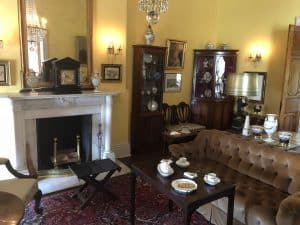 Dr. William Thornton, architect of the first U.S. Capitol and a family friend, designed the grand neoclassical house, which was completed in 1816.
Dr. William Thornton, architect of the first U.S. Capitol and a family friend, designed the grand neoclassical house, which was completed in 1816.
The estate remained under continuous Peter family ownership through six generations spanning 178 years, its rooms a destination for leading politicians, military leaders, and dignitaries.
Following the death, in 1983, of Armistead Peter 3rd, the founders’ great-great-grandson, the site opened to the public as a museum in 1988 in accordance with his wishes.
Now a historic house and garden museum, it remains one of the nation’s few historic urban estates retaining the majority of its original landscape. (Source)
The history, the views (both political and that of society) have changed little over the years. After the tour, we set out for downtown Georgetown. There were several restaurants listed on our “Pack Up and Go” sheet and we wanted some lunch.
As we were walking, we discovered an Apple Store on the main street. We went in to see if they could fix Teresa’s screen. I was expecting them to replace the phone (or offer her an upgrade). They didn’t, they said they could fix it and it would take about an hour and a half. I asked them if they could also replace her battery while they had it open (since she had been complaining about the battery life lately too). They agreed and we left her phone there and set off to explore more of the local area. On our list was a place called “Pinstripes”.
PinStripes
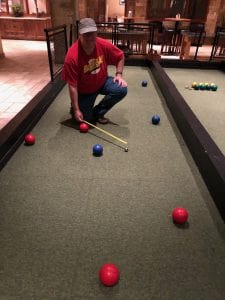 Pinstripes was restaurant/brew house that also had a bowling alley and Bocce ball. We had time to kill and the hostess gave us a tour of the place. They lanes were mostly full and I was not sure I wanted to bowl anyway. The Bocce courts were open and empty and we decided to give it a try.
Pinstripes was restaurant/brew house that also had a bowling alley and Bocce ball. We had time to kill and the hostess gave us a tour of the place. They lanes were mostly full and I was not sure I wanted to bowl anyway. The Bocce courts were open and empty and we decided to give it a try.
We ordered drinks and took to one of the courts. We had seen Bocce played on few TV shows like “Amazing Race”, but had played ourselves. We set up and proceeded to play as best as we could. We got to our table and found our waitress had brought us a complimentary dessert.
After several rounds, a waiter happened by and noticed we were not scoring properly. He stopped and explained the rules and the scoring of Bocce.
He left us to play more properly and returned to our table with another complimentary dessert. We were going to be on a sugar high for a week.
After an hour and a half, we headed back up to pick up Teresa’s iPhone. It was fully charged and ready to go. This made Teresa happy. We left and headed down to the Potomac river. We wanted to take a river cruise down to Alexandria.
Potomac River
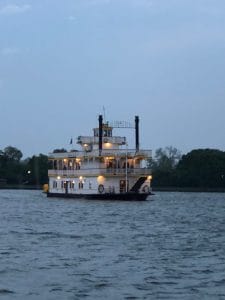 We boarded a boat and headed down river. The Potomac has a great history of transport and commerce. Forts once lined the river too. Steamships and Paddleboats used to service the area daily.
We boarded a boat and headed down river. The Potomac has a great history of transport and commerce. Forts once lined the river too. Steamships and Paddleboats used to service the area daily.
The Potomac River is located within the Mid-Atlantic region of the United States and flows from the Potomac Highlands into the Chesapeake Bay. The river (main stem and North Branch) is approximately 405 miles (652 km) long with a drainage area of about 14,700 square miles (38,000 km2). In terms of area, this makes the Potomac River the fourth largest river along the Atlantic coast of the United States and the 21st largest in the United States. Over 5 million people live within the Potomac watershed.
The river forms part of the borders between Maryland and Washington, D.C., on the left descending bank and West Virginia and Virginia on the river’s right descending bank. The majority of the lower Potomac River is part of Maryland. Exceptions include a small tidal portion within the District of Columbia, and the border with Virginia being delineated from “point to point” (thus various bays and shoreline indentations lie in Virginia). Except for a small portion of its headwaters in West Virginia, the North Branch Potomac River is considered part of Maryland to the low water mark on the opposite bank. The South Branch Potomac River lies completely within the state of West Virginia except for its headwaters, which lie in Virginia. (Source)
Alexandria, VA

Alexandria, like DC and Georgetown has been the home to many historical figures.
The historic center of Alexandria is known as “Old Town”. With its concentration of boutiques, restaurants, antique shops and theaters, it is a major draw for all who live in Alexandria as well for visitors. Like Old Town, many Alexandria neighborhoods are compact and walkable. It is the 7th largest and highest-income independent city in Virginia.
A large portion of adjacent Fairfax County, mostly south but also west of the city, is named “Alexandria,” but it is under the jurisdiction of Fairfax County and separate from the city; the city is sometimes referred to as the City of Alexandria to avoid confusion (see the “Neighborhoods” paragraph below). In 1920, Virginia’s General Assembly voted to incorporate what had been Alexandria County as Arlington County to minimize confusion. (Source)
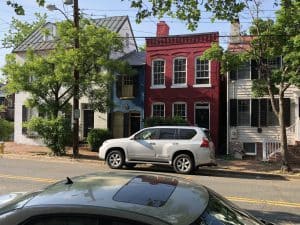 We thought it would be a time to do a little geocaching in the area. We found several. One of those led us to the the smallest/narrowest home. It is called the Hollensbury Spite House and it is only 25 feet deep and 7 feet wide. (source) Neither of us could imagine living in a home this small.
We thought it would be a time to do a little geocaching in the area. We found several. One of those led us to the the smallest/narrowest home. It is called the Hollensbury Spite House and it is only 25 feet deep and 7 feet wide. (source) Neither of us could imagine living in a home this small.
We cached for a few hours before deciding to grab dinner and head back. Both of our phones were warning us or severe storms in the area.
The next day was really just a half day. We needed to get back to the airport and home. We still had some time though. We had done quite a bit of walking over the past few days. We did not want to walk much. We decided to check out the National Building Museum.
National Building Museum

The National Building Museum transforms understanding of the history and impact of architecture, engineering, landscape architecture, and design. Through exhibitions, educational programs, and special events, we welcome all ages to experience stories about the built world and its power to shape our lives, communities, and futures. The Museum resides in one of the most awe-inspiring places in Washington, D.C., with a soaring Great Hall, colossal 75-foot-tall Corinthian columns, and a 1,200-foot terra cotta frieze. (source)
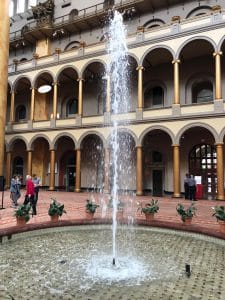
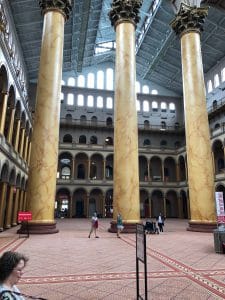 In the exhibits, we learned how the US built new towns for whatever the needs (like around the exploration of Nuclear energy).
In the exhibits, we learned how the US built new towns for whatever the needs (like around the exploration of Nuclear energy).
We also saw exhibits on the inequality of housing, and small home living (which gave us some ideas of what we would like to do in our home.
It was time to go home, to return to the rat race.

